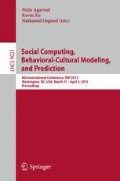Abstract
We are interested in how preference correlations can impact policy-maker productivity and their satisfaction with resultant policy. We applied a simulated annealing process as a model of revising draft legislation in peer and committee reviews before submission to a floor vote. Results indicate that having exogenous, common issue priorities is required for productivity but that some structures inhibit productivity, particularly where preference schedules are uncorrelated. Our model also demonstrates lower system efficiency, and lower overall satisfaction, as policy is negotiated through compromise to achieve higher production.
We wish to thank Maksim Tsvetovat who introduced us to applications of simulated annealing to Organizational Theory and inspired us to extend it, adapt it, and to think about organizations and processes where it seems to fit especially well. We also thank an anonymous reviewer for helpful feedback provided on a previous draft of this paper.
Access this chapter
Tax calculation will be finalised at checkout
Purchases are for personal use only
Preview
Unable to display preview. Download preview PDF.
References
Aldrich, J.: Why Parties?. University of Press, Chicago (1995)
Barabási, A.-L., Albert, R.: Emergence of scaling in random networks. Science 509(5439), 509–512 (1999)
Bratton, K., Rouse, S.: Networks in the legislative arena: How group dynamics a ect co-sponsorship. Legislative Studies Quarterly 36(3) (2011)
Cox, G.W., McCubbins, M.: Legislative Leviathan: Party Government in the House. University of California Press (1993)
Cox, G., McCubbins, M.: Setting the Agenda. Cambridge University Press (2005)
Gilligan, T., Krehbiel, K.: Asymmetric information and legislative rules with a heterogeneous committee. American Journal of Political Science 33(2) (1989)
Granovetter, M.: Threshold models of collective behavior. American Journal of Sociology 83(6) 1420–1443 (1978)
Humphries, M.D., Gurney, K.: Network “small-worldness": A quantitative method for determining canonical network equivalence. PLoS One 3(4) (2008)
Kingdon, J.: Congressmen’s Voting Decisions. University of Michigan Press (1989)
Kirkpatrick, S., Gelatt, C., Vecchi, M.P.: Optimization by simulated annealing. Science 220 (1983)
Krehbiel, K.: Information and Legislative Organization. University of Michigan Press (1991)
Krehbiel, K.: Pivotal Politics: A Theory of US Lawmaking. Chicago University Press (1998)
Mayhew, D.: Congress: The Electoral Connection (1974)
McKelvey, B.: Toward a complexity science of entrepreneurship. Journal of Business Venturing 19 (2004)
McPherson, M., Smith-Lovin, L., Cool, J.: Birds of a feather: Homophily in social networks. Annual Review of Sociology 27 (2001)
Metropolis, N., et al.: Equations of state calculations by fast computing machines. Journal of Chemical Physics 21(6) (1953)
Shepsle, K., Weingast, B.: The institutional foundations of committee power. The American Political Science Review 81(1) (1987)
Watts, D.J., Strogatz, S.H.: Collective dynamics of ‘small-world’ networks. Nature 393(6684), 440–442 (1998)
Author information
Authors and Affiliations
Corresponding author
Editor information
Editors and Affiliations
Rights and permissions
Copyright information
© 2015 Springer International Publishing Switzerland
About this paper
Cite this paper
Atherley, S., Dillon, C., Kane, V. (2015). A Model of Policy Formation Through Simulated Annealing: The Impact of Preference Alignment on Productivity and Satisfaction. In: Agarwal, N., Xu, K., Osgood, N. (eds) Social Computing, Behavioral-Cultural Modeling, and Prediction. SBP 2015. Lecture Notes in Computer Science(), vol 9021. Springer, Cham. https://doi.org/10.1007/978-3-319-16268-3_10
Download citation
DOI: https://doi.org/10.1007/978-3-319-16268-3_10
Published:
Publisher Name: Springer, Cham
Print ISBN: 978-3-319-16267-6
Online ISBN: 978-3-319-16268-3
eBook Packages: Computer ScienceComputer Science (R0)

